One finger cannot lift a pebble,” says an African proverb. The significance of working together cannot be over-emphasized—especially now, when the road to attaining food security and poverty alleviation is riddled with challenges such as decreasing agricultural lands, depleting natural resources, looming climate change, diseases, and poor investment in agriculture. It is for this reason that the International Rice Research Institute, the Africa Rice Center (AfricaRice), the International Center for Tropical Agriculture (CIAT), and many other organizations have come together to design an innovative solution anchored on partnerships.
Aptly named the Global Rice Science Partnership (GRiSP), this “mega” program aims to help billions of people around the world who largely depend on rice as their daily source of nourishment.
A global blueprint
“The development of GRiSP has given a great impulse to the reform agenda of the CGIAR,” said Dr. Carlos Pérez del Castillo, chair of the CGIAR Board, during the Third International Rice Congress (IRC2010) held in Hanoi, Vietnam, last 8-12 November, where GRiSP was formally launched. “International agricultural research has continuously played a key role in helping increase the world’s food production.”GRiSP represents—for the first time ever—a single strategic blueprint for global rice research and how it can contribute more effectively to solving development challenges at the local, national, and regional levels. It is a Consultative Group on International Agricultural Research (CGIAR) Research Program (CRP) under the theme “sustainable crop productivity for global food security.” It streamlines current research for development of the CGIAR.
In harmony with the CGIAR
The mission of GRiSP is synchronized with that of the CGIAR, that is, to reduce poverty and hunger, improve human health and nutrition, reduce the environmental footprint, and enhance ecosystem resilience of rice production systems through high-quality international rice research, partnership, and leadership.
In harmony with the CGIAR’s objectives, GRiSP laid out three specific aims: (1) to increase rice productivity and value for the poor in the context of a changing climate through accelerated demand-driven development of improved varieties and other technologies along the value chain; (2) to foster more sustainable rice-based production systems that use natural resources more efficiently, are adapted to climate change and are ecologically resilient, and have reduced environmental externalities; and (3) to improve the efficiency and equity of the rice sector through better and more accessible information, improved agricultural development and research policies, and strengthened delivery mechanisms.
Breaking the poverty cycle
To achieve its goals, GRiSP plans to foster high-quality, impact-oriented research and development activities in a global context. Strategically, the key point for farmers to enter into a virtuous circle is to raise the productivity and resource efficiency of rice production systems to unprecedented levels (see Fig. 1). Better income will enable farmers to invest more in diversification and sustainable management practices—improving their food security, nutrition, health, and the environment.
All about rice
The overarching organizing principle of the partnership is rice-based production systems and value chains (the “from field to market principle”). All research will use an interdisciplinary approach in which targeting and prioritizing are based on a clear understanding of the different targeted environments, management systems, and market segments. On the one hand, this will need a broad range of scientific, or upstream, partners to seek out innovations and, on the other hand, many partnerships at the grass-roots level for both dissemination and feedback.
The result will be accelerated development of international public goods across the whole rice sector. Based on these considerations and for effective management of the research and development process, the program components are structured into six major rice research and development themes:
(1) harnessing genetic diversity to chart new productivity, quality, and health horizons;
(2) accelerating the development, delivery, and adoption of improved rice varieties;
(3) ecological and sustainable management of rice-based production systems;
(4) extracting more value from rice harvests through improved quality, processing, market systems, and new products;
(5) technology evaluations, targeting, and policy options for enhanced impact; and
(6) supporting the growth of the global rice sector.
Vision of success
GRiSP has a clear view of what it wants to see in the future. It laid out concrete and quantifiable key impacts to benefit the poor, the hungry, and the environment in the next 25 years.
By 2035, those living under the US$1.25 (PPP) poverty line will reduce their expenditures by $11 billion annually (holding consumption constant). Spending less while gaining more income would mean that 150 million people would be lifted above the $1.25 poverty line, reducing global poverty by 11%.
As rice becomes more available and its price goes down, 62 million undernourished people would be able to consume sufficient calories per day in Asia—thus reducing the number of hungry Asians by 12%.
For the environment, nearly 1 billion tons of carbon dioxide equivalent emissions will stay clear of Earth’s atmosphere. Over a global 25-year inflation-adjusted investment of roughly $3 billion, or for every $20 of investment, one person is lifted above poverty—an efficient development investment that has a high return in poverty eradication.
For the past 50 years, countries such as Thailand and Vietnam, among others, have been transformed into leaders in the rice industry—a metamorphosis that could not have occurred without a revolution in rice cultivation. Now, with GRiSP’s concretely laid-out vision of success, innovative and holistic approach, and the concerted efforts of hundreds of institutions that share a similar vision, the future will continue to make a difference in the lives of the poor around the world.
Dr. Robert Zeigler, IRRI director general, hopes that, “Through GRiSP, we can advance rice science and its application to reduce poverty and hunger, improve human health and nutrition, and create a better environment.”
___________________
Dr. Dobermann is a soil scientist and agronomist with 25 years of experience working in Asia, North America, and Europe. He is recognized internationally as an authority on science and technology for food security and sustainable management of the world’s major cereal cropping systems.









